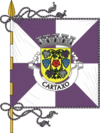Cartaxo
| Cartaxo | |||
|---|---|---|---|
| Municipality | |||
|
|||
 |
|||
| Coordinates: 39°9′N 8°47′W / 39.150°N 8.783°WCoordinates: 39°9′N 8°47′W / 39.150°N 8.783°W | |||
| Country |
|
||
| Region | Ribatejo | ||
| Subregion | Lezíria do Tejo | ||
| Intermunic. comm. | Lezíria do Tejo | ||
| District | Santarém | ||
| Parishes | 6 | ||
| Government | |||
| • President | Paulo Jorge Vieira Varanda (PS) | ||
| Area | |||
| • Total | 158.17 km2 (61.07 sq mi) | ||
| Population (2011) | |||
| • Total | 24,462 | ||
| • Density | 150/km2 (400/sq mi) | ||
| Time zone | WET/WEST (UTC+0/+1) | ||
| Area code | 243 | ||
| Website | http://www.cm-cartaxo.pt | ||
Cartaxo (Portuguese pronunciation: [kɐɾˈtaʃu]) is a municipality in the district of Santarém in continental Portugal. The population in 2011 was 24,462, in an area of 158.17 km². The urbanized centre of Cartaxo had a population of 9,507 in 2001.
In written and oral history, the territory of Cartaxo was an important point in the interior of the country. A Roman road, crossing Alenquer (Lerabriga), connected ancient Olissipo (Lisbon) to Santarém (Scallabis) through the territory of Cartaxo. Yet, before the Romans, other civilizations settled in the region, establishing castros in Vila Nova de São Pedro, Vale do Tejo or in the areas of Muge.
Situated in the plains of the Ribatejo, Cartaxo was a battleground between Muslim and the Christians. Due to its proximity to Santarém, it was one of the centres disputed between Muslim and Christian forces for years, resulting in the destruction of Cartaxo. King Sancho II of Portugal found it necessary to repopulate the area, since it was located in a privileged position with fertile lands. He, therefore, assigned the land of Cartaxinho (today Ribeira do Cartaxo) to Pedro Pacheco, who was responsible for constructing a shelter for the poor, a task that neither Pedro Pacheco nor his descendants would accomplish.
Oral tradition suggests that the name Cartaxo was given to the lands by Queen Elizabeth of Portugal who, on a journey to the Monastery of Almoster, stopped to rest and quench her thirst. Alongside a spring, she was surprised by the beautiful song of an unfamiliar bird. Asking one of the peasants about the songbird, the serf responded that the song came from a bird of the kind called cartaxos or cartaxinhos. Enchanted by the place, the Queen ordered that the land, then called Lugar da Fonte, receive the name Lugar do Cartaxo. It is unclear whether there is any truth to this story.
In 1312, Cartaxo received its first foral (charter), signed in Leiria by King Denis of Portugal, confirmed in 1487 by King John II (in Santarém), and in 1496 by Manuel (also in Santarém). The first foral, issued by Denis on 21 March 1312, was sent to his vassal, Garcia Martins, originating the foundation of the locality of Cartaixo. In this act, Denis exempted the region from taxes for those who grew and cultivated grapes during the first five years of their tenure. Settlers who accepted these land rights were required in return to present each year an eighth of their produce in wine and linen.
...
Wikipedia


